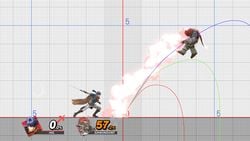Distance unit

A distance unit (often shortened to unit), symbol u, refers to an arbitrary unit of measurement that calculates the in-game position and size of objects.
Overview[edit]
Many aspects of video games are reliant on distance to perform specific interactions, ranging from how a character moves, physics engine interactions, to how scenes are rendered. A common practice in 3D games is to correlate units to a real-world measurement (e.g. 1 unit = 1 meter), which is commonly done with games that are based on the real-world in order for level design, movement, physics, etc. to accurately/predictably be replicated.
In the original Super Smash Bros., Masahiro Sakurai claims that one unit is equal to 1/3cm.[1] Starting in Super Smash Bros. Melee and remaining unchanged in all games since, the unit size was redefined to be an estimated one decimeter, or 1 unit = 0.1 meters;[2] the exception to this is hitboxes in Melee, where the units are about 256 times smaller than other units (i.e. a hitbox with a radius of 2000 would be similar to a radius of 7.8125 in later games). As a result, the "modern" unit is about 30 times the "original" unit, and units between all games can be compared fairly easily. Despite units being compared to real-world units, the size of something in Smash Bros. is generally based on feel and balance, rather than its actual size in its home series or real life.
Applications[edit]
Hitboxes and hurtboxes use units to define their position and size. The majority of character attributes are measured in "units per frame", such as jump force, walk speed, run speed, air speed, falling speed, and so on. Accelerative stats such as air acceleration and gravity measure in units/frame², and frictional stats such as traction and air friction use negative units/frame². Very few attributes use a different system, such as weight.
Super Smash Bros. Melee introduced the concept of glancing blows. A glancing blow is activated when a hitbox and an opponent's hurtbox overlaps by 0.01 units or less. Later games, beginning with Super Smash Bros. Brawl, widen this range to 0.1 units.
Melee also introduced results screen statistics, many of which are measured by units. These include the total amount of distance a character is launched and the highest amount of knockback dealt and received. These statistics convert in-game units to real life units, the type of units varying by game and region, which are calculated appropriately. These include feet/meters for launch distance and miles/kilometers per hour for highest knockback.
The Training stage in Super Smash Bros. Ultimate has a background that uses a grid. This grid is intended to have each line be 1 unit apart, however this correlation was performed on the squares between the grid lines while ignoring the size of the grid lines themselves. The texture for the grid uses 15×15 pixel squares with 1 pixel wide grid lines, resulting in the grid lines being 1.06 (16/15) units apart.